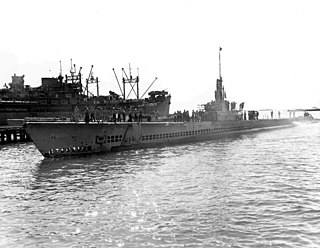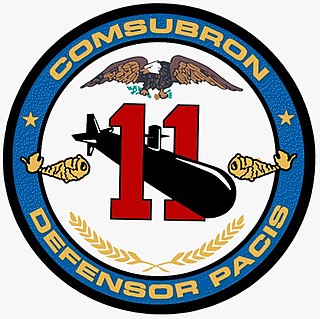
USS Lionfish (SS-298), a Balao-class submarine, was the only ship of the United States Navy named for the lionfish, a scorpaenid fish native to the Pacific and an invasive species found around the Caribbean. She was designated a National Historic Landmark in 1986, and is now on display at Battleship Cove in Fall River, Massachusetts.

USS Bream (SS/SSK/AGSS-243), a Gato-class submarine, was the first ship of the United States Navy to be named for the bream.

USS Asheville (SSN-758), is a Los Angeles-class nuclear powered fast attack submarine. She is the fourth vessel of the United States Navy to be named for Asheville, North Carolina. The contract to build her was awarded to Newport News Shipbuilding and Dry Dock Company in Newport News, Virginia on 26 November 1984 and her keel was laid down on 9 January 1987. She was launched on 24 February 1990, sponsored by Mrs. Dorothy Helms, and commissioned on 28 September 1991.

USS Ronquil (SS-396), a Balao-class submarine, was the only ship of the United States Navy named after the ronquil, a spiny-finned fish found along the northwest coast of North America. It has a single dorsal fin and a large mouth and resembles the tropical jawfish.

USS Oak Ridge (ARD-19/ARDM-1) was originally a United States Navy Auxiliary floating drydock suitable for dry docking destroyers, submarines and landing craft, built by the Pacific Bridge Company. In the early 1960s she was upgraded to support Los Angeles-class submarines, and re-classified as ARDM-1-class. A stern door and enclosed bow design allows for open ocean transits. The dock is non-propelled and therefore must be taken under tow to operational areas of the fleet. A steering mechanism with twin rudders is installed to facilitate this operation. Sufficient electrical power was provided by four diesel-driven generator sets to maintain all normal and operational requirements. Living, berthing, and mess facilities are provided for the dock's complement of 5 officers, 10 CPO's and a crew of 186.

USS Holland (AS-3) was a submarine tender that served in the United States Navy before and during World War II. Holland was launched by the Puget Sound Naval Shipyard, Bremerton, Washington on 12 April 1926, sponsored by Miss Elizabeth Saunders Chase, daughter of Admiral J. V. Chase, and commissioned on 1 June, Comdr. John B. Earle in command. Stationed at San Diego, California, tending submarine divisions there with periodic tours to Panama to service submarines based at the Canal Zone pre-World War two. Later serving in the Pacific theatre, by close of hostilities having given 55 instances of refit to submarines, provided repair and service to 20 surface craft and completed various jobs on shore installations.

A depot ship is an auxiliary ship used as a mobile or fixed base for submarines, destroyers, minesweepers, fast attack craft, landing craft, or other small ships with similarly limited space for maintenance equipment and crew dining, berthing and relaxation. Depot ships may be identified as tenders in American English. Depot ships may be specifically designed for their purpose or be converted from another purpose.

Submarine Squadron 11 is a squadron of submarines based at Point Loma Submarine Base, San Diego, California, United States. Submarine Squadron 11 was commissioned July 1, 1986, aboard her flagship, McKee, at Naval Submarine Base Point Loma, San Diego. Their missions include anti-submarine, anti-surface, strike, special and mine warfare, intelligence, surveillance and reconnaissance. The squadron currently consists of four Los Angeles-class submarines for deployments to the Western Pacific, Indian Ocean and the Persian Gulf.
United States ship naming conventions for the U.S. Navy were established by congressional action at least as early as 1862. Title 13, section 1531, of the U.S. Code, enacted in that year, reads, in part,
The vessels of the Navy shall be named by the Secretary of the Navy under direction of the President according to the following rule: Sailing-vessels of the first class shall be named after the States of the Union, those of the second class after the rivers, those of the third class after the principal cities and towns and those of the fourth class as the President may direct.

An Auxiliary repair dock (ARD) is a type of floating drydock employed by the U.S. Navy, especially during World War II. The Navy commissioned 33 ARD vessels: ARD-1 through ARD-33. ARDs were self-sustaining in World War II. ARDs have a rudder to help in tow moving, making ARDs very mobile, and have a bow to cut through waves. ARDs have a stern that can be opened or closed. The stern can be closed with bottom-hinged flap gate, operated by hydraulic rams. This stern gate can be lowered for ship entrance into the submerged dock, and then closed to keep out waves. ARDs were built by the Pacific Bridge Company, in Alameda, California.

Commander, Submarine Force, U.S. Pacific Fleet (COMSUBPAC) is the principal advisor to the Commander, United States Pacific Fleet (COMPACFLT) for submarine matters. The Pacific Submarine Force (SUBPAC) includes attack, ballistic missile and auxiliary submarines, submarine tenders, floating submarine docks, deep submergence vehicles and submarine rescue vehicles throughout the Pacific.
HMS Osprey was a three-funnel, 30-knot destroyer ordered by the Royal Navy under the 1896–1897 Naval Estimates from Fairfields. She was the fifth ship to carry this name since it was introduced in 1797 for an 18-gun ship-sloop.
Two ships of the United States Navy have been named Arco for Arco, Idaho.

USS Endurance (ARDM-3) was originally laid down as ARD-18, a non self-propelled United States Navy Auxiliary floating drydock in 1944. Built by the Pacific Bridge Company in Alameda, California. During World War II USS ARD-18 was assigned to the Asiatic-Pacific Theater and serviced ships at Guadalcanal and Ulithi. After the war, floating dry dock ARD-18 was sent to Norfolk Shipbuilding and Drydock Corp.'s yard, circa 1967-68 and was lengthened by adding a 100 ft (30 m) midsection as well as an additional deck above the uppermost crane deck. Redesignated Medium Auxiliary Repair Dry Dock Endurance (ARDM-3), she served until retirement in 1995.

Shippingport (ARDM-4) is an ARDM-4-class United States Navy Medium Auxiliary Repair Dry Dock. She is one of the Navy's two medium auxiliary repair dry docks, and was the first floating dry dock built for the US Navy since World War II. Laid down in 1977, delivered and placed in service on 4 January 1979, she is still in service at the Naval Submarine Support Facility at Naval Submarine Base New London, in Groton, Connecticut.

USS Waterford (ARD-5) was an Auxiliary floating drydock that served in the United States Navy during World War II, the Korean War, the Vietnam War, and the Persian Gulf War. She later served the Chilean Navy as Talcahuano (133).

An auxiliary floating drydock is a type of US Navy floating dry dock. Floating dry docks are able to submerge underwater and to be placed under a ship in need of repair below the water line. Water is then pumped out of the floating dry dock, raising the ship out of the water. The ship becomes blocked on the deck of the floating dry dock for repair. Most floating dry docks have no engine and are towed by tugboats to their destinations. Floating dry docks come in different sizes to accommodate varying ship sizes, while large floating dry docks come in sections and can be combined to increase their size and lift power. Ballast pontoon tanks are flooded with water to submerge or pumped dry to raise the ship.

Pacific Bridge Company was a large engineering and construction company. During World War II, Pacific Bridge Company of Alameda, California was selected to build US Navy Auxiliary Repair Docks (ARD) a type of Auxiliary floating drydock and Type B ship barges.
















